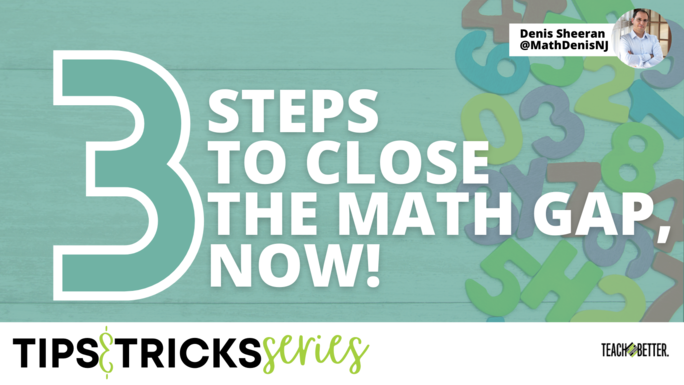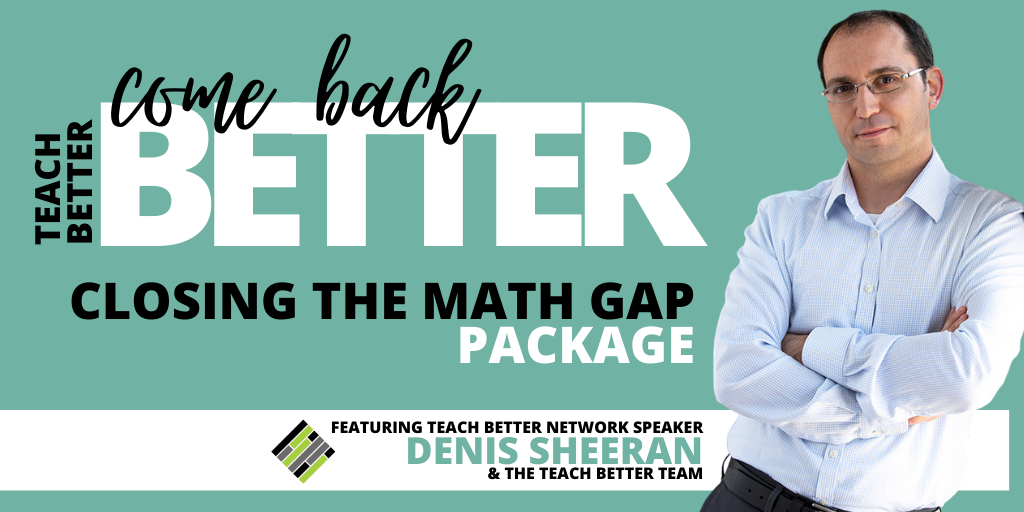TL;DR:
- We must meet students where they are. There is not a math gap, only a distance you must travel to meet your students.
- First, determine where the students are. Then plan, implement, reflect, adapt, and repeat.
- Be sure to advocate for your students, your method, and your plan.
For many of us, this past calendar year has felt a lot like living in some kind of alternate parallel universe. Things are not as they should be. We have less control than we want over our careers, our classrooms, and our own lives. And then, as if trying to grapple with the changes, fear, disillusionment, and uncertainty wasn’t enough, you get slapped in the face with “3 Steps To Close The Math Gap, NOW!”
Well, we are in an alternate universe, and things are not as they seem.
And since things are not as they seem, let’s search for truth. Here is the truth I’ve found.
There is no math gap.
But…Denis…you said in the title that…but…I’m confused. Let me clarify. I did lie to you in the title, but only a little bit. There’s technically only ONE way to close the math gap, not three. And, since the math gap doesn’t exist, the way we close it is to stop talking about it and do something different.
You see, the reason there is no math gap is because we have constructed views over the years that have told us where “students need to be” by a certain age, grade, or benchmark point in their learning. But what happens if, oh, let’s say there’s a hypothetical global pandemic that forces school districts everywhere to abandon their traditional structure, implement virtual schooling, discontinue standardized tests including final exams, focus more on health and safety than ever before, and do it in their own way despite what the school district next door or 2,000 miles away is doing?
Could you even imagine if that happened and then, after a few months someone said, “Hey, it looks like kids aren’t as far along in math as they used to be. They should be! Let’s do something!” Those views we constructed about student achievement and curriculum simply do not apply right now, and since the National Math Gap Measurement System and Finger Pointing Society (which I just made up) is based entirely on those views, the math gap simply does not exist.
Our goal is NOT that we complete the delivery of a certain amount of math instruction, it's that our students learn math, and as much math as they can learn while we have them with us! Click To TweetSo where do we go from here? If you didn’t watch the clip from The Matrix yet, jump back up and do it now, or again if you did.
Waiting…Waiting…Ok!
Think of that message. “Do not try and bend the spoon. That’s impossible. Instead, only try to realize the truth. There is no spoon. Then you’ll see that it is not the spoon that bends, it is only yourself.” In that quote, we find our solutions.
Since there is no gap, we cannot close it. Instead, realize the truth. Our students did not receive the complete math curriculum we anticipated that they would, in the classroom setting we had prepared for them, with the culture and engagement we had intended to develop.
Therefore, instead of closing a gap, we must move to them to meet them where they are. It isn’t the gap that we close, it is only ourselves who move.
Our goal is NOT that we complete the delivery of a certain amount of math instruction, it’s that our students learn math, and as much math as they can learn while we have them with us!
STEP 1 to Close the Math Gap: Determine Where the Students Are.
I’m old, so at points in my life, I have gotten lost while driving and didn’t have a GPS or phone nearby to help out. So the first thing I had to do was determine my location.
At that moment, how I got there and how to get out of there were both important questions, but the latter was my focus, as it is ours in the math classroom. We know how we got here, so we need to take time to look around us, identify landmarks, signs, and indicators and make some decisions about where to go.
For teaching our students, that means deeply authentic assessment. That may come in the form of one-on-one conversations where you watch a student complete a math task, an intentional pre-assessment for each topic to eliminate assumptions about student content mastery, or other forms your school or team of teachers has developed that you know will identify individual student needs.
If you choose to teach lessons and content on a pacing schedule without doing this, you’re asking the students to meet you where YOU are, and as we all know, it’s impossible to bend the spoon. Need some help? There are some excellent posts about assessment in this blog series.
STEP 2 to Close the Math Gap: Plan, Implement, Reflect, Adapt, Lather, Rinse, Repeat…
Once we know where our students are, as individuals who might need an individualized pathway or as groups who can grow together, we simply cannot put that knowledge aside and pull out the old lesson from the textbook or program and teach it as if everyone in the room was the same.
We must plan for how to take each student or group of students forward on their journey. That may mean a student needs your attention for remediation or advancement, or that a group can work together to investigate their designated lesson without you, or that, for a time, a technology tool will be able to help students progress more effectively and efficiently than either you or the group.
You may need to restructure your class period to include less direct instruction or more, or take the homework out of class and introduce Lagging Homework (more about that in Hacking Math). No matter the plan, it must be as valuable for the individual student as possible.
Then as teachers, we watch them, listen to them, provide feedback that helps them get through those riverbend moments of their learning without jumping to the rescue when they’re struggling productively. If our plan worked, we continue.
If not, we reflect and change. Then we do it again, and again, and again and again and again. I can’t give you those plans. Only you can decide on them for your students.
[scroll down to keep reading]STEP 3 to Close the Math Gap: Advocate. For your students, your method, and your plan!
Dear Supervisor/Principal/Director/Whomever,
I’ve studied the material taught over the past year and have learned what my students know and do not know, what they understand and do not understand, and what they can apply and cannot apply. Due to our COVID-19 schedule changes, less content was effectively learned than in past years.
It will take time to make sure that each and every student of mine and in this school have the opportunity to learn that content and apply it to their future education and their lives. It will take longer than this school year. Our state assessment scores will not be the same. Communication with parents and the community will be of the utmost importance.
My colleagues and I ask for understanding and flexibility and the time to make a plan for reaching our students affected by this and those who will enter our classrooms next year. We want our students to learn math, to learn it well, and when they see an opportunity to use it, to feel confident that they can. What do we need to do to make a flexible, adjustable, student-based response plan that you can support?
Sincerely,
You
Advocate on behalf of your students.
They are each unique individuals who can come out on the other side of this with both a full understanding of the mathematics we wanted them to learn and a new understanding of the care, concern, trust, and respect we have for each of them and hopefully transfer all of those new skills to the world in which they live.
As a teacher, I saw results when students were re-humanized and advocated for. As an administrator, I knew when teachers were supporting students and when they weren’t. Advocacy and communication work.
It is not the spoon that bends, it is only yourself.
There is not a math gap, only a distance you must travel to meet your students.
The Teach Better Team is here to help. I’m here to help.
Walk the distance to your students. Turn, face forward alongside them, then move together.
Click here to see the full blog series!
About Denis Sheeran
Denis Sheeran the author of two books for teachers, Instant Relevance, Using Today’s Experiences to Teach Tomorrow’s Lessons, and Hacking Mathematics: 10 Problems That Need Solving. He travels across the country delivering keynotes, full day workshops, and small group professional development to teachers and administrators.
Denis has a Masters Degree in Educational Leadership and a Bachelor’s Degree in Mathematics Education with a minor in Music and is pursuing his doctorate in Curriculum and Instruction. He taught high school math, from Algebra to Advanced Placement, for thirteen years at Lake Forest High School in Lake Forest, Illinois and supervised the mathematics programs in Sparta, Edison, Weehawken, and Chatham NJ. Denis lives in Sparta, NJ with his wife, four children.




